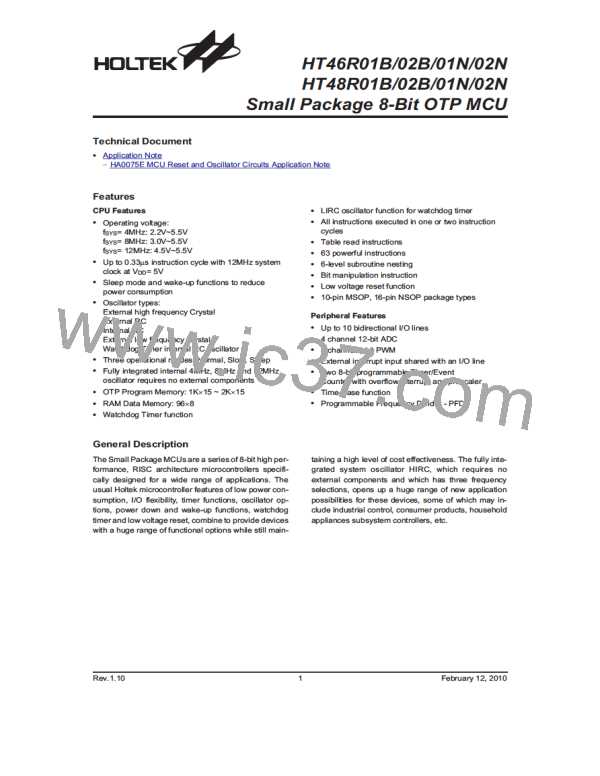HT46R01B/02B/01N/02N
HT48R01B/02B/01N/02N
Pulse Width Modulator
The device contains an 8-bit PWM function. Useful for
such applications such as motor speed control, the
PWM function provides outputs with a fixed frequency
but with a duty cycle that can be varied by setting partic-
ular values into the corresponding PWM register.
bit2~bit7 is denoted here as the DC value. The second
group which consists of bit0~bit1 is known as the AC
value. In the 6+2 PWM mode, the duty cycle value of
each of the four modulation sub-cycles is shown in the
following table.
DC
PWM Operation
Parameter
AC (0~3)
i<AC
(Duty Cycle)
A single register, known as PWMn and located in the
Data Memory is assigned to each Pulse Width Modula-
tor channel. It is here that the 8-bit value, which repre-
sents the overall duty cycle of one modulation cycle of
the output waveform, should be placed. To increase the
PWM modulation frequency, each modulation cycle is
subdivided into two or four individual modulation sub-
sections, known as the 7+1 mode or 6+2 mode respec-
tively. The required mode and the on/off control for each
PWM channel is selected using the CTRL0 register.
Note that when using the PWM, it is only necessary to
write the required value into the PWMn register and se-
lect the required mode setup and on/off control using the
CTRL0 register, the subdivision of the waveform into its
sub-modulation cycles is implemented automatically
within the microcontroller hardware. The PWM clock
source is the system clock fSYS. This method of dividing
the original modulation cycle into a further 2 or 4
sub-cycles enable the generation of higher PWM fre-
quencies which allow a wider range of applications to be
served. The difference between what is known as the
PWM cycle frequency and the PWM modulation fre-
quency should be understood. As the PWM clock is the
system clock, fSYS, and as the PWM value is 8-bits wide,
the overall PWM cycle frequency is fSYS/256. However,
when in the 7+1 mode of operation the PWM modulation
frequency will be fSYS/128, while the PWM modulation
frequency for the 6+2 mode of operation will be fSYS/64.
DC+1
64
Modulation cycle i
(i=0~3)
DC
64
i³AC
6+2 Mode Modulation Cycle Values
The following diagram illustrates the waveforms associ-
ated with the 6+2 mode of PWM operation. It is impor-
tant to note how the single PWM cycle is subdivided into
4 individual modulation cycles, numbered from 0~3 and
how the AC value is related to the PWM value.
7+1 PWM Mode
Each full PWM cycle, as it is controlled by an 8-bit PWM
register, has 256 clock periods. However, in the 7+1
PWM mode, each PWM cycle is subdivided into two indi-
vidual sub-cycles known as modulation cycle 0 ~ modula-
tion cycle 1, denoted as i in the table. Each one of these
two sub-cycles contains 128 clock cycles. In this mode, a
modulation frequency increase of two is achieved. The
8-bit PWM register value, which represents the overall
duty cycle of the PWM waveform, is divided into two
groups. The first group which consists of bit1~bit7 is de-
noted here as the DC value. The second group which
consists of bit0 is known as the AC value. In the 7+1
PWM mode, the duty cycle value of each of the two mod-
ulation sub-cycles is shown in the following table.
PWM
PWM Cycle PWM Cycle
DC
Parameter
AC (0~1)
i<AC
Modulation
Frequency
Duty
(Duty Cycle)
f
SYS/64 for (6+2) bits mode
SYS/128for (7+1) bits mode
DC+1
128
Modulation cycle i
(i=0~1)
f
SYS/256
[PWM]/256
f
DC
i³AC
6+2 PWM Mode
128
Each full PWM cycle, as it is controlled by an 8-bit PWM
register, has 256 clock periods. However, in the 6+2
PWM mode, each PWM cycle is subdivided into four in-
dividual sub-cycles known as modulation cycle 0 ~ mod-
ulation cycle 3, denoted as i in the table. Each one of
these four sub-cycles contains 64 clock cycles. In this
mode, a modulation frequency increase of four is
achieved. The 8-bit PWM register value, which repre-
sents the overall duty cycle of the PWM waveform, is di-
vided into two groups. The first group which consists of
7+1 Mode Modulation Cycle Values
The following diagram illustrates the waveforms associ-
ated with the 7+1 mode PWM operation. It is important
to note how the single PWM cycle is subdivided into 2 in-
dividual modulation cycles, numbered 0 and 1 and how
the AC value is related to the PWM value.
Rev.1.10
40
February 12, 2010

 HOLTEK [ HOLTEK SEMICONDUCTOR INC ]
HOLTEK [ HOLTEK SEMICONDUCTOR INC ]